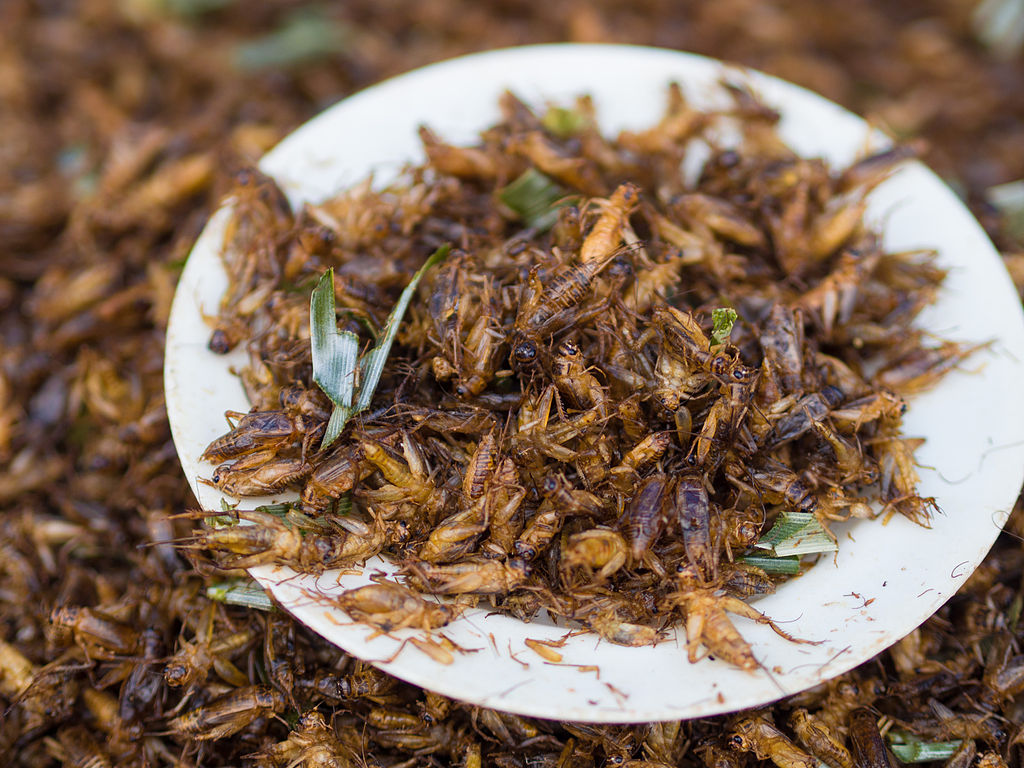By Jason Rothauser
 “And how much is that per cricket?” I ask. I’m standing in front of the reptile cages of a local Brooklyn pet store.
“And how much is that per cricket?” I ask. I’m standing in front of the reptile cages of a local Brooklyn pet store.
“Ten cents a pop.” Sounds reasonable.
“I’ll take forty.”
In a minute or two, the clerk has wrapped up the insects in a large plastic bag, the same way you’d take a goldfish home from the fair. They’re mottled brown and reassuringly lively, hopping frantically against the top of their enclosure like popping corn.
As the clerk rings up my order, she jokes, “Salt, pepper, ketchup?” She doesn’t know just how close to the mark she is.
These crickets aren’t for a pet lizard. They’re on tonight’s menu.
It’s hard to think of a stronger culinary taboo than eating insects. Many Americans can barely abide the presence or even the sight of them, but billions of people around the globe regularly consume a wide variety of insect life. The reason is simple: insects are nutritious, incredibly energy efficient, and even tasty. The reason that we all should eat insects is even simpler: it might help to save the planet.
Our current system of global food production is not sustainable. A 2006 United Nations Food and Agriculture Organization report found that our present levels of meat production contribute 14–22% of the greenhouse gasses produced in the world in a given year. As the developing world continues to eat more like America does (i.e., much more carbon-intensive meat instead of produce), this proportion will only grow. The reason livestock like cattle are so ecologically deleterious is the inefficiency that comes with raising them. It takes eight pounds of feed to grow just one pound of beef. Insects, by comparison, turn food energy into body mass much more efficiently: a ratio of about 2:1 feed to body mass. And while producing livestock on a large scale requires “monocrops” of corn that themselves are harmful to the environment, insects can be fed on agricultural byproducts and other organic matter that would otherwise go to waste.
For these reasons, many people have come to see insects as a potential magic bullet to our dual challenges of climate change and food insecurity. All we need to do is harvest these energy-efficient (and highly nutritious) food sources, and then reap the gains of the reduced need for much more costly and wasteful livestock.
I’ve endorsed these views for years, but outside of the odd chocolate-covered cricket, I had never really dug in. I decided it was time to put my principles into practice—if I think the world should try eating bugs, I needed to be willing to do so myself. Which is what led me to that pet shop, strolling outside with a few dozen or so soon-to-be cricket hors d’oeuvres.
I decided to try cooking crickets because they are popular and easy-to-handle for cooking. A quick Google search nets scores of recipes, from stir-fried crickets to cricket flour. But, for my first foray into entomophagy, I wanted to keep it simple. I didn’t want to hide the fact that I was eating insects in a sauce or a taco, I wanted to stare them in the face. Thus I decided on dry roasting. Crickets apparently make a naturally crispy, nutty snack.
First, I popped the hopping bag into the fridge. About an hour at a cold temperature slows the insects down and makes them quiescent. In that state, it is easy to drop them into a pot of boiling water for a few minutes (most recipes seem to recommend this as the first step to kill and sterilize the animals). I have to admit at this point feeling a little strange. Fishing dead crickets out of my saucepan with a slotted spoon is not like making an omelet. But I press on.
Next, the crickets go on a baking sheet (they’re now a bit limp and somewhat pale) into a 200 ° oven for about an hour or so. You know they’re done when they crunch a bit when pressed with the back of a spoon. The final step is crucial. With their legs, wings, and antenna intact, the crickets still seem unpleasantly “buggy.” The solution is simple: take the crickets gently between your hands and roll them back and forth – this breaks off the wings and appendages, leaving you with something resembling a large rice grain with a small head.
Now for the big taste test. The flavor is somewhat shrimpy, yet nutty and surprisingly complex, a bit like a shrimp cracker crossed with a cashew. The texture is crunchy and light, and there is surprisingly little in the way of a gross-out factor. These won’t become my new favorite snack, but that was more because I don’t particularly love shrimp crackers. I could easily see crickets working with a more complex dish— perhaps adding protein and texture to a spicy salsa or guacamole, or mixed up in a stir fry.
What is clear is that insects aren’t ready for prime time on the American dinner table. First, while I was assured by the internet that consuming crickets from a pet store was safe, I’m not sure the Food and Drug Administration would agree. Second, for their small weight, these crickets were expensive (my $4 worth of crickets, once cooked, would barely fill a couple of shot glasses). But there are signs of development. Companies such as Exo and Chapul market and sell energy bars made from processed crickets, while others offer cricket flower, or chocolate-covered bugs. We are a long way from crickets on your average restaurant menu, but the first murmurs of a trend are there. The death of a taboo begins one small (occasionally six-legged) step at a time.
